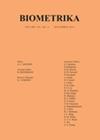对连续暴露和二元结果的匹配观察研究进行敏感性分析
IF 2.8
2区 数学
Q2 BIOLOGY
引用次数: 0
摘要
摘要 在观察性研究中,匹配是调整测量混杂因素最广泛使用的研究设计之一。然而,未测量的混杂因素可能存在,且无法通过匹配去除。因此,通常需要进行敏感性分析,以评估因果结论对未测量混杂因素的敏感性。针对二元暴露的敏感性分析框架已经在各种匹配设计中得到了很好的应用,并在各种研究中得到了普遍使用。然而,与二元暴露情况不同的是,除了配对匹配等一些特殊情况外,对于连续暴露仍然缺乏有效和通用的敏感性分析方法。为了填补二元结果情况下的这一空白,我们为连续暴露和二元结果的一般匹配设计开发了一个敏感性分析框架。首先,我们使用概率晶格理论来证明我们的灵敏度分析方法在费雪尖锐无效条件下是有限人群精确的。其次,我们证明了一个新颖的设计敏感性公式,它是渐近评估我们的敏感性分析方法性能的有力工具。第三,为了允许二元结果的效应异质性,我们引入了一个框架,通过混合整数编程对二元结果的广义归因效应进行渐进精确推断和敏感性分析。第四,对于连续结果的情况,我们表明,在暴露和结果都是连续的情况下,在配对观察研究中进行渐进精确的敏感性分析一般是 NP-困难的,除了一些特殊情况,如配对匹配。在实际数据应用中,我们将新方法应用于研究早期铅暴露对青少年犯罪的影响。本研究方法的实现可在 R 软件包 doseSens 中找到。本文章由计算机程序翻译,如有差异,请以英文原文为准。
Sensitivity analysis for matched observational studies with continuous exposures and binary outcomes
Summary Matching is one of the most widely used study designs for adjusting for measured confounders in observational studies. However, unmeasured confounding may exist and cannot be removed by matching. Therefore, a sensitivity analysis is typically needed to assess a causal conclusion’s sensitivity to unmeasured confounding. Sensitivity analysis frameworks for binary exposures have been well-established for various matching designs and are commonly used in various studies. However, unlike the binary exposure case, there still lacks valid and general sensitivity analysis methods for continuous exposures, except in some special cases such as pair matching. To fill this gap in the binary outcome case, we develop a sensitivity analysis framework for general matching designs with continuous exposures and binary outcomes. First, we use probabilistic lattice theory to show our sensitivity analysis approach is finite-population- exact under Fisher’s sharp null. Second, we prove a novel design sensitivity formula as a powerful tool for asymptotically evaluating the performance of our sensitivity analysis approach. Third, to allow effect heterogeneity with binary outcomes, we introduce a framework for conducting asymptotically exact inference and sensitivity analysis on generalized attributable effects with binary outcomes via mixed- integer programming. Fourth, for the continuous outcomes case, we show that conducting an asymptotically exact sensitivity analysis in matched observational studies when both the exposures and outcomes are continuous is generally NP-hard, except in some special cases such as pair matching. As a real data application, we apply our new methods to study the effect of early-life lead exposure on juvenile delinquency. An implementation of the methods in this work is available in the R package doseSens.
求助全文
通过发布文献求助,成功后即可免费获取论文全文。
去求助
来源期刊

Biometrika
生物-生物学
CiteScore
5.50
自引率
3.70%
发文量
56
审稿时长
6-12 weeks
期刊介绍:
Biometrika is primarily a journal of statistics in which emphasis is placed on papers containing original theoretical contributions of direct or potential value in applications. From time to time, papers in bordering fields are also published.
 求助内容:
求助内容: 应助结果提醒方式:
应助结果提醒方式:


